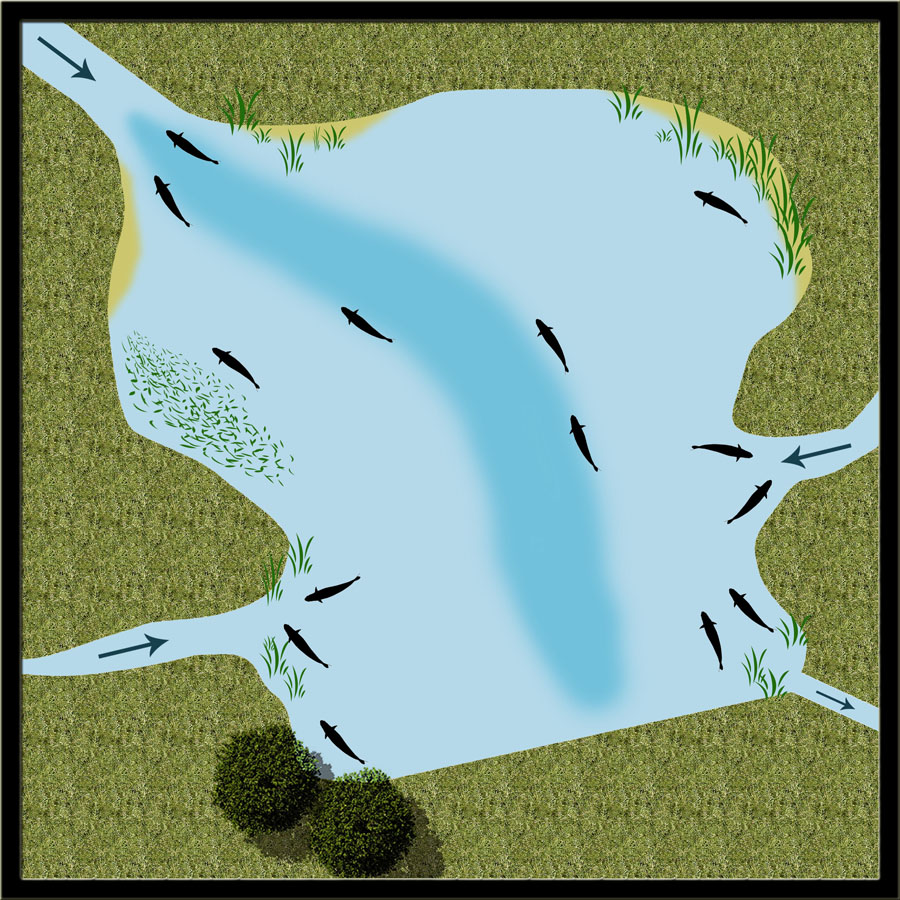I often find it strange that people are intimidated by rivers and yet think of dams and lakes as their friends. Yes, it’s true that still waters are often easier to fish, especially when they’re maintained specifically for that purpose, but in rivers the fish have fewer places to hide and the water is easier to read.
When one approaches a still water, especially a relatively large one, they are met with an expanse of water with endless places for fish to hide. It’s also relatively unclear as to what lies beneath that glassy surface. Is it deep or shallow? Is there a lot of structure? And most importantly, where are all the fish?
As such deciding where to start fishing is not always an easy decision. I suppose one can fish their way around the entire water looking for the fish, but this is a time consuming exercise and involves the fisherman spending long periods fishing water which holds no fish.
A lot of fly fishermen speak of the 90/10 rule, meaning that 90% of the fish lie in only 10% of the water (some more optimistic people refer to this as the 80/20 rule). So how exactly, in a still water, do we go about finding this 10% of the water which holds the majority of the fish? After all, fishing the other 90% of the water will result in few to no fish for a large amount of time and effort.
Thankfully this is not as difficult as one might imagine and there is a light at the end of the tunnel. If you start to think like a fish, and learn where they’re likely to lie, you’ll spend far less time fishing empty water and far more time catching fish.
So here it is, Baha Fly Fishing’s guide to Trout lies in still waters.
Finding Trout in still waters can be difficult and frustrating due to the large number of factors which affect them. These include (and are not limited to) the time of year, temperature, pressure, size of the water, depth of the water, food availability and structure.
Sadly some of these factors, such as temperature and pressure, are out of our control. Plus a lot of us are limited to fishing over the weekend and, whether or not the pressure is falling or it’s too hot or cold, we still head for the water since it’s our only opportunity to do so.
But don’t get despondent yet, thankfully a lot of the other factors ARE in our control. We can generally tell the depth of the water by looking at the shape of the valley and the height of the dam wall. We can often see the structure and the weed beds. And we know that, despite the conditions, the Trout have nowhere to go and are therefore somewhere in that water – all we need to do is find them.
Before we move on I’ll quickly illustrate how we can deal with some of the factors that seem out of our control. Living in Durban I often find myself fishing waters when the temperature is perhaps a little high for Trout. Thankfully water is a good insulator and, as you’ll no doubt know, generally the deeper one goes the cooler it gets. As such when I find myself fishing on these hot days I often spend a lot more time fishing deep and slow since I know the fish would’ve sought out the cooler water and are probably feeling a little lethargic from the heat. I may not catch as many fish in these situations, but at least I still catch fish.
Getting back to the 90/10 rule; so how exactly do we find this prime water holding most of the fish?
Below is a diagram showing some of the common lies for Trout in still waters. These are the areas you should focus on (or at least start at) when fishing such a water. Some of them are easy to find while others may be more difficult, but with practice it will eventually become second nature to spot these key areas.
Submerged structure, for example, may require clear water for you to see or perhaps take you snagging a fly on it to realise it’s there. Alternatively a fish finder can help out here, but this is rarely an option when fishing from the bank and not many anglers have them on their tubes. In fact, this is more common place in America where Trout fishing often takes place on massive waters off of boats.
Another piece of advice I received (and sadly I can’t remember from whom) is to go to the still water during the dry season or a drought. The water level will be a lot lower allowing you to mark out areas with good structure which you can target once the water level has returned to normal.

Let’s now discuss the various Trout lies as seen in the above diagram.
Inlets
The inlet to a still water is always a good place to start when searching for Trout (if it is flowing of course).
Firstly it provides a constant supply of food to the still water in the form of insects being washed down the stream. Trout, much like humans, want as much as possible for as little effort as possible. Sitting in the inlet means the food comes to them instead of them having to go to the food.
Secondly, the inlet also provides a source of cool water which can be important in the warmer months and on hotter days.
Depending on the size of the inlet Trout can also move into this area during spawning season to deposit their eggs and to breed.
And finally, this water is also usually well oxygenated by the stream or river.
Beaches
Another good area to target Trout in is the small, shallow beaches often found in dams. Minnows often gather here and Trout will move into these bays to feed off them when they feel safe (usually early morning and late afternoon when the sun is not directly over them making them more visible).
Weed beds and reeds
Weed beds are one of the better known lies for Trout. This is of course since they are a prime source of food for the fish. There is an abundance of food to be found in the weed beds from worms in the mud, to dragon fly nymphs amongst the weeds to small baitfish looking for shelter. Since Trout feed on all of these they often patrol the edge of weed beds hunting for food.
Many insects bread in the weed beds and a most of these insects will eventually require air to breath. They will therefore head for the surface at some stage thus making themselves easy pickings for Trout.
Weed beds also provide cover for Trout which feel very vulnerable to predators such as Otters and Cormorants.
Underwater Features
Trout (and most fish for that matter) will be attracted to structure. As with all of the above structure will provide either food or shelter or both. In the case of submerged structure look out for reefs, rocks, boulders, old trees, logs, etc. All of these are likely lies for Trout.
Overhanging Vegetation
Overhanging vegetation is another favourite lie for Trout. Not only does it provide shelter from the sun on hot days but it also provides a consistent food source in terms of terrestrial insects which are blown or fall off the vegetation and into the water.
Once again it also provides the Trout with cover.
Drop offs
Another popular lie for Trout is along drop offs. A prime example of this is the old riverbed (in the case of dams). Sadly this is not the easiest place to find, but by inspecting the shape of the valley one can normally establish roughly where the old riverbed ran.
I often try and fish these drop offs during the midday heat since it?s both a good lie and is likely to be the source of cooler water.
Drop offs are also a good location for fishing along while moving from one lie to another.
Outlet
Our final lie for Trout is near the outlet of the dam. This is once again since food will usually be concentrated here (if of course water is flowing out of the outlet). Even though the water looks to be still in the dam, it will slowly be flowing out of the dam. As such food will slowly be washed towards the outlet and Trout will be found here taking advantage of this free delivery of food.
Temperature Bands
This is not a location in itself (as it moves daily if not hourly) but is rather important none the less.
Trout enjoy water in the region of 12 – 18 degrees Celsius. As you may imagine the surface water is often warmer as it is in direct contact with the sun (warm water also rises). As such as it gets warmer you may need to fish deeper (in general).
Try fishing different depths at all of the above mentioned lies until you find the band of water which the fish are sitting in.
Also remember that temperature inversion occurs in water. As such if the water is incredibly cold there is often a band of warmer water deeper down. Again try and find this band of water as this is where the fish will be located.
So in summary, fish the areas where there is an abundance of food and/or cover for the Trout, and ignore the rest of the water (at first anyway) as these areas will produce far less fish than the above mentioned lies.
Remember that fish will move between these areas and lurk around them. As such fish can be found anywhere in the water, but why not focus on the high concentration areas rather than on where they may be. Also remember that fish patrol these areas, so just because you didn?t catch on your first few casts doesn?t mean you won?t catch. Give each area a fair chance.
And before we end off this month’s article, here are a few extra tips which may improve your hook up rate in still waters.
- Be discreet. Hide from the fish since they do get easily spooked. Don?t wear bright colours and place yourself behind bushes or grass where you?ll be less visible.
- Know your flies and how they behave. Know how fast they sink since this will affect how long you need to wait for them to reach the desired water. Do they splash when they hit the water? Not a good idea when casting to sighted fish. Etc.
- Fish the down-wind bank. This is since food will be blown to this bank and as such the Trout will gather here to feed.
- Trout generally face into the current so they will be facing into the wind. Remember this while in your tube or on the bank so as to not spook them. Always try and approach Trout from behind.
Until next time, tight lines!
